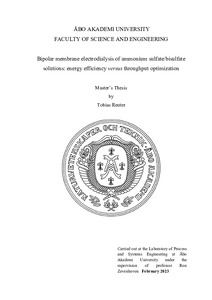Bipolar membrane electrodialysis of ammonium sulfate/bisulfate solutions : energy efficiency versus throughput optimization
Reuter, Tobias (2023)
Reuter, Tobias
2023
Julkaisu on tekijänoikeussäännösten alainen. Teosta voi lukea ja tulostaa henkilökohtaista käyttöä varten. Käyttö kaupallisiin tarkoituksiin on kielletty.
Julkaisun pysyvä osoite on
https://urn.fi/URN:NBN:fi-fe2023030730378
https://urn.fi/URN:NBN:fi-fe2023030730378
Tiivistelmä
To combat carbon emissions, carbon capture and storage becomes an increasingly urgent topic. The most common way of carbon dioxide capture and storage is geological storage in, for example, depleted oil or gas reservoirs. However, geological storage is not possible in some parts of the world, such as Finland. Thus, to avoid carbon dioxide transportation to remote locations, other methods are needed.
This thesis deals with a process for carbon capture and storage by mineralisation (CCSM) developed at Åbo Akademi University, where magnesium is extracted from rock using ammonium bisulfate or sulfuric acid, forming magnesium sulfate. The magnesium sulfate reacts with carbon dioxide in the presence of aqueous ammonia, to form magnesium carbonate and ammonium sulfate.
Bipolar membrane electrodialysis (BPMED) can be used to recycle the substances used in the CCSM process, by converting a salt to an acid and a base using bipolar membranes and electricity for water dissociation and ion separation. This thesis focuses on energy use and efficiency versus throughput optimization for the BPMED part of the CCSM process. The optimization was carried out by running tests on a BPMED lab-scale pilot unit and analysing the results.
It was determined that the sodium hydroxide electrode rinse solution, a solution that carries electricity between the electrodes and the membrane stack, caused leakage to the base solution stream. Thus, it was replaced by ammonium sulfate, which caused less leakage.
Furthermore, comparing ammonium sulfate and ammonium bisulfate as BPMED product solutions, it was determined that ammonium sulfate is more beneficial for the process, since less of it needs to be separated.
One problem with separating ammonium salts, using BPMED, is the low conductivity of the generated aqueous ammonia. This increases the resistance in the membrane stack, which makes the process less efficient. Thus, efforts to raise base stream conductivity were made by adding ammonium sulfate and magnesium sulfate to the base stream. Magnesium sulfate did, however, cause precipitation inside the membrane stack, which can make the process less efficient. Thus, ammonium sulfate was considered the only viable option for increasing the base solution conductivity.
Instead of adding ammonium sulfate to the base stream, a two-compartment stack can be used. Here, only the anions are separated generating an acid and a mixture of base solution and product solution. Thus, the conductivity remains high in the base/product stream until the end of the process. This configuration is currently being tested at Åbo Akademi University at the time of writing this thesis, showing promising results.
This thesis deals with a process for carbon capture and storage by mineralisation (CCSM) developed at Åbo Akademi University, where magnesium is extracted from rock using ammonium bisulfate or sulfuric acid, forming magnesium sulfate. The magnesium sulfate reacts with carbon dioxide in the presence of aqueous ammonia, to form magnesium carbonate and ammonium sulfate.
Bipolar membrane electrodialysis (BPMED) can be used to recycle the substances used in the CCSM process, by converting a salt to an acid and a base using bipolar membranes and electricity for water dissociation and ion separation. This thesis focuses on energy use and efficiency versus throughput optimization for the BPMED part of the CCSM process. The optimization was carried out by running tests on a BPMED lab-scale pilot unit and analysing the results.
It was determined that the sodium hydroxide electrode rinse solution, a solution that carries electricity between the electrodes and the membrane stack, caused leakage to the base solution stream. Thus, it was replaced by ammonium sulfate, which caused less leakage.
Furthermore, comparing ammonium sulfate and ammonium bisulfate as BPMED product solutions, it was determined that ammonium sulfate is more beneficial for the process, since less of it needs to be separated.
One problem with separating ammonium salts, using BPMED, is the low conductivity of the generated aqueous ammonia. This increases the resistance in the membrane stack, which makes the process less efficient. Thus, efforts to raise base stream conductivity were made by adding ammonium sulfate and magnesium sulfate to the base stream. Magnesium sulfate did, however, cause precipitation inside the membrane stack, which can make the process less efficient. Thus, ammonium sulfate was considered the only viable option for increasing the base solution conductivity.
Instead of adding ammonium sulfate to the base stream, a two-compartment stack can be used. Here, only the anions are separated generating an acid and a mixture of base solution and product solution. Thus, the conductivity remains high in the base/product stream until the end of the process. This configuration is currently being tested at Åbo Akademi University at the time of writing this thesis, showing promising results.
